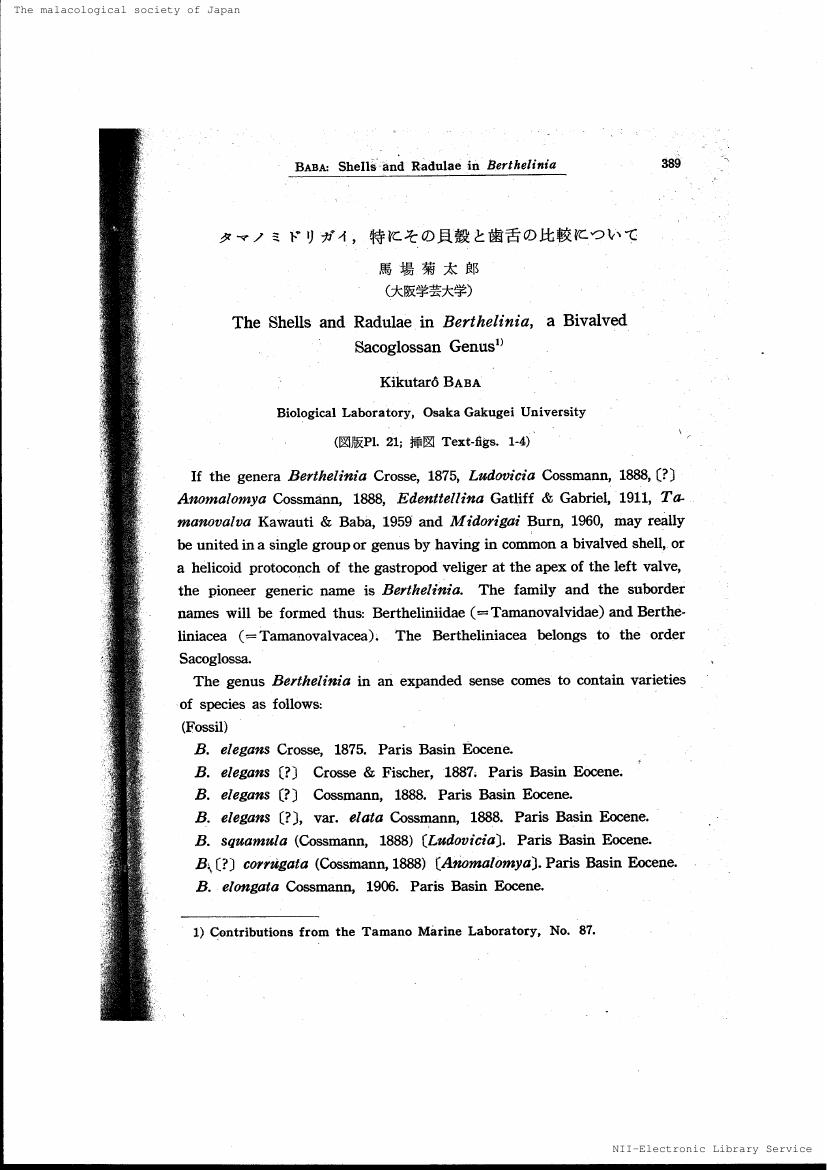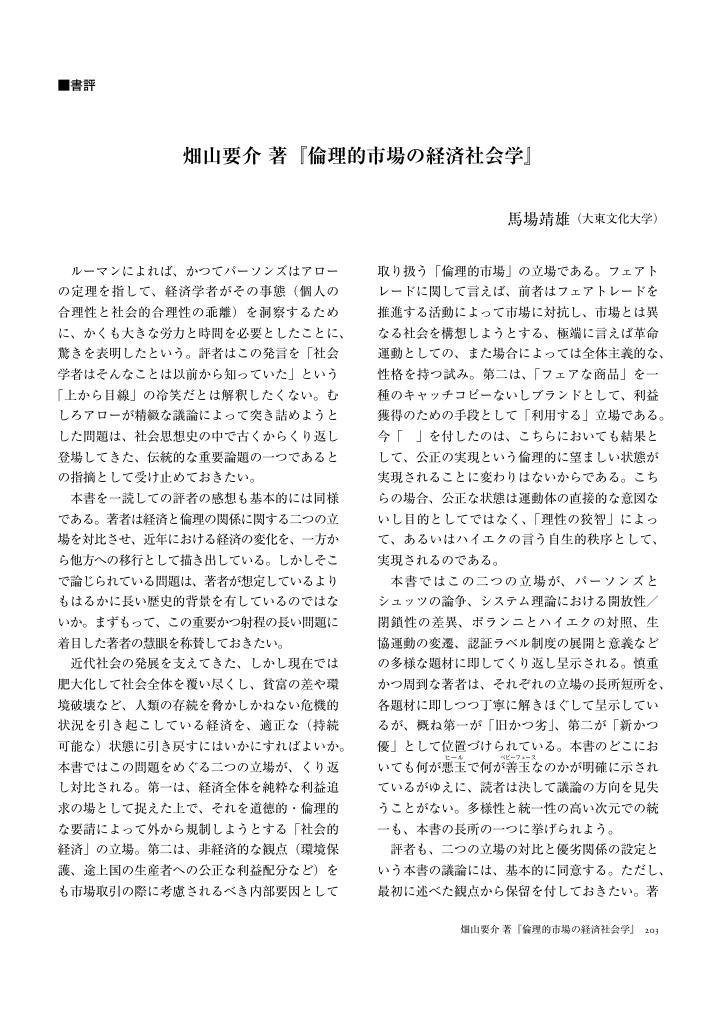- 著者
- 島田 均 吉田 博一 田中 晃 佐藤 成彦 清水 宏明 森 朗子 馬場 廣太郎
- 出版者
- 一般社団法人 日本アレルギー学会
- 雑誌
- アレルギー (ISSN:00214884)
- 巻号頁・発行日
- vol.44, no.8, pp.1045, 1995-08-30 (Released:2017-02-10)
- 著者
- 馬場 朗
- 出版者
- 東京女子大学
- 雑誌
- 東京女子大学紀要論集 (ISSN:04934350)
- 巻号頁・発行日
- vol.73, no.1, pp.65-124, 2022-09-30
This third and final part of this study (its seventh, eighth and concluding sections), the former parts (its former six sections) of which are already published in the latest issues of this Bulletin (vol. LXXII (n.2), 2021, and vol.LXXIII (n.1), 2021), focuses on the later works of Condillac such as the Grammaire (1775 (its drafting began, however, possibly from 1758)), the Logique (1780) and the Langue des calculs (1798 (posthumous publication)), to verify Condillac’s constant elaboration, since the Essai sur l’origine des langues (1746) passing through the Traité des sensations (1754), of integrating aesthetic expressivity in the empiricist manner into his epistemological system, an elaboration inseparable from his renovation of French aesthetic classicism. This article examines the impact of the aesthetic visual dimension on the relation between “langage d’action” and “analyse” based on the “analogie de la nature” and the metaphor of “peintre habile” in the Grammaire (the seventh section of this study), on the “ordre simultané” in the Logique (1780) (the former part of the eighth section), and on “langage d’action” as the primordial way of calculation and “tableau mouvant” in the Langue des calculs (the latter part of the eighth section). After having concluded that the aesthetic visibility of the simultaneous “ordre” plays a decisive role not only for the development of his epistemological empiricism system but also for his empiricism renovation of the French Classicism, this paper further examines the positive actuality of Condillac’s aesthetic thought as well as its insufficiency for new aesthetic experiences, based on the attractive and inexhaustible otherness or grace, irreducible to the enjoyment of the static stability of “ordre”.本研究は、哲学者エティエンヌ・ボノ・ド・コンディヤックの『人間認識起源論』(一七四六年)を中心に、彼の経験論哲学の美学的射程を検証する一連の試みの結論をなす第三部である。この第三部では、コンディヤックのパルマ滞在期から晩年に至る三つの著作、『文法』、『論理学』そして『計算の言語』における「全体瞬時性(simultanéité)」概念を検証する。『人間認識起源論』では「想像力」を介しての「行動言語」論と特に「倒置」論で、『感覚論』では「全体瞬時的」な「視覚」の生成論で、それぞれ浮上した概念である。注意すべきは、「全体瞬時性」が「自然」の「類比」に基づく「分解・(再)合成」による「分析」と協働関係にあることである。この協働関係も実は、『人間認識起源論』でも既に潜在的に示された関係であるが、『感覚論』を経て、一貫して『文法』・『論理学』・『計算の言語』で進展させられる。第七章では『文法』の「卓越した画家」、第八章では『論理学』の「全体瞬時な秩序」そして『計算の言語』の「動くタブロー」、以上の関連概念群を順次検証し、この進展過程を明らかにする。その上で、本研究全体の結論として、『人間認識起源論』の感性的表現論が古典主義美学をコンディヤックの経験論によって革新したものであること、そしてその美学的議論が晩年に至るまで彼の経験論的認識論自体を支えるものであったこと、以上を提示する。この結論を踏まえた上で本論末尾では、コンディヤックによるこの新たな古典主義の美学一般における重要な意義とその問題点を明らかにする。
1 0 0 0 OA 国家/市場/共同体と公共性、法の役割 法と公共性の社会理論試論
- 著者
- 馬場 健一
- 出版者
- 日本法社会学会
- 雑誌
- 法社会学 (ISSN:04376161)
- 巻号頁・発行日
- vol.2008, no.68, pp.65-78, 2008 (Released:2017-01-31)
1 0 0 0 OA 訪問看護師が在宅重症心身障害児の母親を支援する際に重要と考えている点
- 著者
- 有本 梓 横山 由美 西垣 佳織 臺 有桂 馬場 千恵 新井 志穂 村嶋 幸代
- 出版者
- 一般社団法人 日本地域看護学会
- 雑誌
- 日本地域看護学会誌 (ISSN:13469657)
- 巻号頁・発行日
- vol.14, no.2, pp.43-52, 2012-03-31 (Released:2017-04-20)
- 被引用文献数
- 5
目的:訪問看護師が在宅重症心身障害児の母親を支援する際に重要と考えている点を明らかにする.方法:重症児のみを対象とするA訪問看護ステーションの訪問看護師6人を対象に,2007年9月にグループ面接を行った.質的記述的分析を参考に,訪問看護師が在宅重症心身障害児の母親を支援する際に重要と考えている点についてコード化し,類似したコードをまとめてサブカテゴリーを,類似したサブカテゴリーをまとめてカテゴリーを作成した.結果:訪問看護師が在宅重症心身障害児の母親を支援する際に重要と考えている点は,支援するうえで重要ととらえている情報と支援姿勢に二分された.重要ととらえている情報は,【母親のケア能力】【母親による子の受け止め方】【母親の性格】【母親の心理状態】【母親の身体状態】【子の身体的状況】【子の能力】【在宅療養への家族のサポート体制】【家族の訪問看護に対する気持ち】【母親と訪問看護師との関係】からなっていた.訪問看護の支援姿勢として,【母親のペースに合わせて段階的にかかわる】【子と家族の生活のなかで子育てを共有する】【長期的なケアを見込み母親と社会をつなぐ】が明らかになった.結論:在宅重症児への訪問看護では,(1)母親の心理状態や生活状態の理解,(2)子や家族の状況に応じた母親のケア能力と家族のサポート体制の強化,(3)母親のペースでの関係構築,(4)長期的視点での関係機関と母親との関係構築が重要と考えられた.
1 0 0 0 OA 手術により虫体を摘出した肝蛭症の1例
- 著者
- 前尾 征吾 中島 公洋 富重 辰幸 立麻 達郎 掛谷 俊和 多田 出 金島 良一 小林 迪夫 高岡 宏行 馬場 稔
- 出版者
- 一般社団法人 日本消化器外科学会
- 雑誌
- 日本消化器外科学会雑誌 (ISSN:03869768)
- 巻号頁・発行日
- vol.22, no.12, pp.2845-2848, 1989 (Released:2011-03-02)
- 参考文献数
- 12
1 0 0 0 OA 6G光無線用高利得光漏れ波型ビーム走査アンテナ
- 著者
- 新井 宏之 橋口 弘 馬場 俊彦
- 出版者
- The Institute of Electronics, Information and Communication Engineers
- 雑誌
- 電子情報通信学会論文誌 B (ISSN:13444697)
- 巻号頁・発行日
- vol.J105-B, no.10, pp.741-748, 2022-10-01
莫大なデータトラヒック量に対応可能な高速大容量通信の実現のため,第6世代移動無線通信では,光無線通信が検討されている.光波帯を無線伝送に用いる場合には空間減衰が大きいため,アンテナには高利得が求められる.また,高利得化により,アンテナのビーム幅が非常に狭くなることから,送受信のリンクを張るためにビーム走査が必要である.本論文では,このような機能を有するアンテナとして光漏れ波アンテナの利得の向上及びその励振方法に焦点を当てた議論を行い,今後の展望について述べる.
1 0 0 0 OA タマノミドリガイ, 特にその貝殻と歯舌の比較について
- 著者
- 馬場 菊太郎
- 出版者
- The Malacological Society of Japan
- 雑誌
- 貝類学雑誌ヴヰナス (ISSN:24330671)
- 巻号頁・発行日
- vol.21, no.4, pp.389-401, 1961-12-31 (Released:2018-01-31)
1 0 0 0 OA 気候変動リスクへの対策行動の規定因
- 著者
- 小杉 素子 馬場 健司
- 出版者
- 社団法人 環境科学会
- 雑誌
- 環境科学会誌 (ISSN:09150048)
- 巻号頁・発行日
- vol.35, no.4, pp.227-236, 2022-07-31 (Released:2022-07-31)
- 参考文献数
- 26
本研究では,人々の気候変動リスクに対する認知や態度,対策行動への取り組みについて現状を把握するとともに,今後対策行動を促進するための示唆を得るためにオンラインでの質問紙調査を実施した。調査結果から,73.8%が地球温暖化は主に人間の活動によると考えており,世代や国・地域を超えた課題であり,影響を防ぐための対策を行う必要があると考える傾向が強いことが示された。対策行動としては,省エネ(64.0%)や熱中症予防のための水分補給(57.5%)などの実施率が高い。対策行動を緩和策と適応策とに区別して実施数を比較すると,緩和策の方が実施されている行動数が多かった。人々の対策の実施数を規定している要因を重回帰分析で調べたところ,緩和策に対しては地球温暖化の影響実感,将来の影響予測,地球温暖化に対する懸念,多少のコストを払ってでも積極的に取り組むべきという姿勢が有意な効果を持っていた。適応策では影響実感と将来予測,地球温暖化に対する疑念や個人の対策行動の無力さの認知,問題の身近さの認知が有意な効果を持つことが示された。つまり,影響実感や将来の影響予測に働きかけることで,緩和策および適応策の対策行動が増える可能性が示唆されるとともに,緩和策は地球温暖化を自分が取り組むべき問題として認識する中で実施され,適応策はむしろ地球温暖化問題への対策としてではなく個別影響への対応として実施されている可能性が示された。
- 著者
- 馬場 香織
- 出版者
- 日本比較政治学会
- 雑誌
- 日本比較政治学会年報 (ISSN:21852626)
- 巻号頁・発行日
- vol.15, pp.135-175, 2013 (Released:2020-03-16)
- 参考文献数
- 45
1 0 0 0 OA EUのなかの国民国家-デモクラシーの変容 はじめに
- 著者
- 馬場 康雄
- 出版者
- 日本比較政治学会
- 雑誌
- 日本比較政治学会年報 (ISSN:21852626)
- 巻号頁・発行日
- vol.5, pp.i-iii, 2003-06-25 (Released:2010-09-09)
1 0 0 0 OA アセタゾラミド投与後意識障害をきたした慢性腎不全の2症例
- 著者
- 庄野 義幸 酒見 隆信 馬場 直樹
- 出版者
- 社団法人 日本透析医学会
- 雑誌
- 日本透析療法学会雑誌 (ISSN:09115889)
- 巻号頁・発行日
- vol.23, no.12, pp.1403-1405, 1990-12-28 (Released:2010-03-16)
- 参考文献数
- 7
アセタゾラミドは, 炭酸脱水素酵素を阻害する薬剤で, 現在利尿剤としてよりもむしろ緑内障の治療, あるいは小児のてんかん治療薬として使用されている. 私たちは, 緑内障合併に対してアセタゾラミドの内服をうけ, 数日後に意識障害をきたした慢性腎不全の2例を経験した. 症例1は2年前より維持血液透析をうけている62歳男性で, 緑内障発作に対してアセタゾラミド0.5g/日の内服後3日目に, 意識障害をきたした. 症例2は糖尿病性慢性腎不全 (Cr 6.2mg/dl) の54歳男性で, 緑内障合併のためアセタゾラミド0.75g/日の内服をうけ3日目に意識障害をきたした. いずれの症例も頭部CT検査で異常を認めず, 脳波上代謝性脳症を呈しアセタゾラミド中止により意識が回復したことより, アセタゾラミドが意識障害の原因と考えられた. 意識障害の機序は明らかでないが, 腎不全によるアセタゾラミドの蓄積が起こり, 脳への直接作用による脳内アシドーシスが関与している可能性が推定された.
1 0 0 0 OA 介護以前の親子関係における精神的自立が介護にあたえる影響―母娘介護の受容に注目して―
- 著者
- 馬場 絢子
- 出版者
- 日本応用心理学会
- 雑誌
- 応用心理学研究 (ISSN:03874605)
- 巻号頁・発行日
- vol.45, no.3, pp.198-206, 2020-03-31 (Released:2020-06-29)
- 参考文献数
- 24
This study aimed to examine the influence of parent-child psychological independence on care burden through acceptance of care. Five hundred thirty-four adult children, who were caring for, or had cared for their parents at home, completed the scales. In analysis one, the acceptance of care scale data was analyzed using factor analysis and confirmed reliability and validity. In analysis two, data were analyzed using a pass analysis with multiple group structural equation modeling to identify the relationship between parent-child psychological independence, the acceptance of care, and care burden, and the care dyad difference between the models. Analysis one showed three factors of the acceptance of care scale: 'confusion and resistance,' 'resignation and hope,' 'active understanding. ' This scale had internal consistency and validity. Analysis two illustrated that 'reliable relationship with a parent' affected 'resignation and hope' and 'active understanding,' and that 'confusion and resistance' and 'active understanding' affected care burden. It was also suggested that dementia affected 'confusion and resistance' in mother-daughter caregiving. Implications for mental support for caregivers were discussed.
1 0 0 0 OA ひので可視光望遠鏡における軌道上コンタミネーションの影響評価
- 著者
- 浦山 文隆 渡辺 吉男 矢野 敬一 馬場 尚子
- 出版者
- 一般社団法人 日本航空宇宙学会
- 雑誌
- 宇宙技術 (ISSN:13473832)
- 巻号頁・発行日
- vol.6, pp.25-30, 2007 (Released:2007-07-24)
- 参考文献数
- 8
- 被引用文献数
- 3 3
太陽観測衛星「ひので」可視光望遠鏡には分子状コンタミネーション付着にセンシティブな光学系が搭載されている.これら付着は,望遠鏡内部に使用されている有機材料からのアウトガスにより生じる.「ひので」は日本時間2006年9月23日に打ち上げられ,同年10月25日から可視光望遠鏡による太陽観測が開始された.観測開始から約2カ月の間,光学系の一つである排熱鏡近傍の温度が急上昇した.この原因として,コンタミネーションが排熱鏡に付着し,排熱鏡の太陽光吸収率が増加した可能性が高いことが判った.また,フライト前に実施した数値解析結果と比較したところ,主鏡及び副鏡での太陽光吸収率変化Δαs計算値は温度データからのΔαs概算値に傾向が概ね一致した.しかしながら,排熱鏡でのΔαs計算値は温度データからのΔαs概算値を下回った.数値解析においては,材料表面からのコンタミネーションの脱着効果,汚染源となる材料の急激な温度上昇を考慮する必要があることが判った.
- 著者
- 馬場 哲
- 出版者
- 東京大学大学院経済学研究科
- 雑誌
- 経済学論集 (ISSN:00229768)
- 巻号頁・発行日
- vol.79, no.2, pp.2-26, 2013-07-01 (Released:2022-03-25)
- 参考文献数
- 15
1 0 0 0 OA 書評 畑山要介 著『倫理的市場の経済社会学』
- 著者
- 馬場 靖雄
- 出版者
- 経済社会学会
- 雑誌
- 経済社会学会年報 (ISSN:09183116)
- 巻号頁・発行日
- vol.39, pp.203-204, 2017 (Released:2021-04-01)
- 著者
- 馬場 伸彦
- 出版者
- 日本映像学会
- 雑誌
- 映像学 (ISSN:02860279)
- 巻号頁・発行日
- vol.108, pp.248-251, 2022-08-25 (Released:2022-09-25)
1 0 0 0 OA 学童期唾液腺芽腫の1例
- 著者
- 大野 優紀 田中 圭一朗 馬場 優治 吉澤 穣治 三澤 健之
- 出版者
- 特定非営利活動法人 日本小児外科学会
- 雑誌
- 日本小児外科学会雑誌 (ISSN:0288609X)
- 巻号頁・発行日
- vol.55, no.4, pp.850-853, 2019-06-20 (Released:2019-06-20)
- 参考文献数
- 9
学童期の唾液腺芽腫を経験したので報告する.症例は12歳女児.出生時から左顎下部の腫瘤を認めていた.大きさの変化はなかったが,最近軽度の圧痛を伴うようになり,当院を紹介受診した.触診上,左顎下部に可動性良好で直径2 cmの弾性やや硬の腫瘤を認めた.本人・家族とも手術を希望したため,全身麻酔下に腫瘤を摘出した.病理診断は,唾液腺芽腫であった.唾液腺芽腫は,世界では50例ほど報告されているが,検索しえた範囲では本邦では初めての報告であった.ほとんどが4歳未満での報告であり,本症例のような学童期での診断例は非常に珍しい.術後1年半経過したが再発は認めておらず,外来にて経過観察中である.







